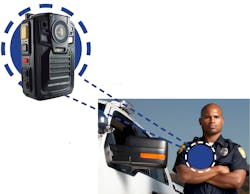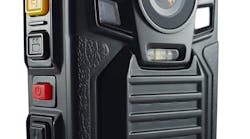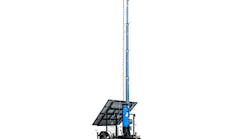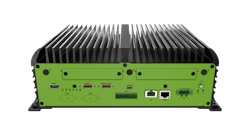The body-worn camera market is new and because of that it has its challenges like any new technology. Born out of the law enforcement industry, body-worn cameras are derived from in-car video surveillance systems, which remain proprietary in 2017.
To make body-worn cameras more affordable – and to open up market opportunities for integrators in this burgeoning technology space – it is going to take a re-birth of the market itself, along with strong technology partnerships.
Through research, we have discovered a large majority of end-users having trouble affording the long-term cloud storage costs simply because no on premise hybrid approach was available at the time of their reactive body-cam purchase. With the influx of new government funding available, system integration companies are positioning themselves to go after the money.
The Birth of the Body Cam Market
When I started out as a systems integrator in 2004, motion jpeg (MJPEG) was dominant, and you would be kicked out of an IT administrator’s office for even the suggestion of putting a 1600x1200 network camera – that cost $3000 – on their network. Today, we have ONVIF – ie open standards – and what appears to be a healthy mix of open-platform video management software, hardware and capture device manufacturers. These systems are integrating with more and more elements of security, from mass notification systems to access control and beyond.
After careful research, development and examination of the emerging body-worn camera market, I learned that most, if not all manufacturers have devised a “closed architecture” approach with absolutely no consideration to integrating the technology with, for example, the police station’s video surveillance system or a city-wide surveillance network.
Key End-User Needs
There was an opportunity to develop an open-architecture body-worn technology; however, I did not initially realize there are justifiable reasons why the two systems do not integrate. I discovered three keys components that law enforcement end-users needed when it came to body cam systems:
1. Secure chain of custody is vital. Evidence captured by body-worn cameras must be 100-percent free of manipulation – meaning the process should be self-contained and a true representation of the images collected on the edge device. Data is captured and stored on the edge via body-worn or dashboard camera, and then after a shift is completed the cameras are docked.
It is important to note that these cameras are not like a GoPro or iPhone that can be plugged into a computer to view the files on stored on the device. They are and should be encrypted at the edge device – making the only way to retrieve the footage by docking them in a proprietary file-uploading docking system, and then and following a coded verification process to access the internal storage and categorize the evidence within the department’s policy.
2. Body cameras are only a tool; officer training in the field is paramount. I had the opportunity to learn from and interview Sergeant Tony Columbus, a 20-plus-year veteran of the Bolingbrook (Ill.) Police Department. He told me there is a specific area of training named “Tactile feel” – the process by which an officer feels muscle tense-up or an indication of resistance, where they are trained to act with force.
This is obviously something beyond the camera’s perspective. When reviewing video, it could appear that an individual was not resisting; however, camera technology cannot pick up this trained sensory indication that is a vital part of police training. Furthermore, the cameras cannot measure stress. Even though they have a wide field of view, they do not have the depth perception and range of the human eye nor the instincts to react.
3. Storage requirements are a moving target. Depending on state and local jurisdiction, storage requirements can range from 30 days to indefinitely – depending on the classification of evidence. My home state of Illinois recently defined its requirements in the SB1304 Act, which “does not require police departments to use body cameras,” but, “if they choose to do so, officers must keep their cameras on when conducting law enforcement activities...Videos will be kept for 90 days, unless flagged for specific reasons.”
The large amount of data being created causes a meaningful problem for law enforcement – how to store this video and where. For example: A police department requiring 20 cameras records eight hours of video per camera daily (factoring 1GB per hour), which equals 8GB per camera per day, for a total of 160GB every day. That’s 14.4TB of data in just 90 days.
One solution is aggregating the data onsite and the using the cloud for storage. It would be anyone’s guess as to what average percentage of that video would be flagged for long-term retention. If a local police department decided to store all this video in the cloud, it could be tens of thousands of dollars in recurring fees for the unforeseeable years to come.
To overcome this obstacle, we recommend only the flagged video to be stored in the cloud via an on-premise hybrid Cloud offering.
Extending Body Cams to Private Industry
Every designed video surveillance system to one level or another has some-sort of blind-spots – even 360-degree cameras. Whether it is a stairwell or a parking lot, many users of video surveillance systems also have patrolling security guards, who need to react quickly. A standard body-worn camera for remote evidence capture should be a vital part of the process.
From situational context, field-of-view, and on-the-spot interviewing with audio-recording, body-worn cameras can be a key tool in overall security operations –and they should become more strongly positioned in 2017 and beyond.
Every security system that depends on guard services as a vital cog in the machine could be improved with a secure way to collect mobile evidence. If a security officer receives a call about a disturbance and is dispatched to investigate, having a hands-free recoding tool would enable a protected audit of how that situation was handled. Inevitably this will create less work and leave less to be interpreted and become a more meaningful part of the overall investigation report.
The challenge for systems integrators is a common one for emerging technology – driving awareness of its capabilities among end-users and markets. As part of an integrator’s quest to become a trusted partner, they could look at 2017 as a starting point to begin designing body-worn cameras as part of a complete video surveillance system.
The Future of Body-Worn Cameras
The future system architecture of body-worn cameras will take a similar path to that network IP cameras – moving from proprietary to open-platform systems. Considering the reality that the video surveillance and body-worn camera markets are really two separate industries, there could be a significant merger of these two industries in the near future.
As data management and chain of custody is a key component of the body-worn camera market, software that enables users to categorize and process evidence from the cameras will be the proverbial “foot in the door” from a technology standpoint for the security industry. The future of this data sharing capability will come via open technology partnerships and live streaming of standard protocols, such as RTSP and ONVIF. That may also open the door for systems integrators to expand into this rapidly ascending technology market.
Thomas Carnevale is CEO and founder of Sentry360, which has developed the SentryMobile line of body cameras and accessories (more info at www.securityinfowatch.com/12189516). Request more info about the company at www.securityinfowatch.com/10215758.



